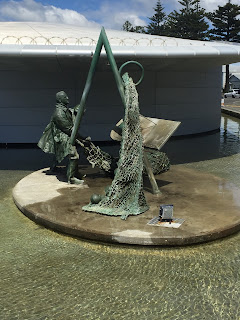 |
| The view from our room |
Napier, our final stop on our East Coast tour, is a town of about 60,000 located at the southern end of Hawke’s Bay and the center of the Hawke’s Bay wine region. We spent two nights to give us a chance to do a bit more exploration of the area. In thinking back over our week on this little self-guided tour, we realized we really needed a couple of weeks to do it justice with more two-night stops. We did do a relatively good job of exploration by limiting our driving distance each day, but that still meant taking a full day to get from one stop to the next leaving little time to explore any place in depth. Still, we don’t really have any regrets. Not many people get a full week to spend out here in this beautiful part of the country (even with the rain) and there is a lot more of New Zealand we won’t see at all.
 |
| Art work on the waterfront |
 |
| Designed for play on the waterfront |
 |
| Lovely park on the waterfront |
Napier has a long and well-documented Maori history. One of the things we have learned during our time here is that the Maori history is well-known and understood here in New Zealand. Nearly every place we have stopped has Maori memorials and/or statues and we can learn that part of the history of the country also. Relations between the whites and Maoris has been a stormy one with much fighting and the standard duplicitous behavior on the side of the British. However, the Maori stood up militarily against these incursions leading to some strong treaties and forcing the British to purchase Maori land in some places.
 |
| All Black souvenirs are available everywhere |
British contact here began with Captain Cook in 1769. By the 1850s, hotel keepers were setting up shop and the British purchased the area in 1851 and set up the town in 1854 named after a general famous for his war record in India. Several street names still reflect this colonial era. The city was completely changed in February, 1931 with a magnitude 7.9 earthquake. During the two and a half minutes 269 people were killed, many more injured, the downtowns of both Napier and nearby Hastings (the larger but less well-known neighboring city) were leveled and 40 square kilometer of the bay was uplifted ten feet becoming land that has become the airport, an industrial area, and farmland. Over 900 aftershocks continued to devastate the town for the rest of 1931, several over 5.0 on the Richter Scale.
 |
| The beach was not here in 1930. It was quite a ways inland. |
 |
They call these the Six Sisters.
Similar to San Francisco's Painted Ladies. |
 |
| The Masonic Hotel, one example of an Art Deco building |
Two navy ships brought medical help and provisions and the town quickly rebuilt in the Art Deco style of the day. A few of these buildings were replaced with more “modern” structures beginning in the 1960s, but in the 1990s, the area was declared a national heritage and no Art Deco buildings have been destroyed since. Today, Napier and Miami Beach are the two best preserved Art Deco communities in the world. Another post highlights those buildings.
 |
| Fishermen outside the aquarium |
 |
| Little Blues in the aquarium |
 |
| We expect to see them in the wild on the South Island |
We did do some wine tasting while in the area. Our first stop was at the Esk River Winery on our way into town. We enjoyed their wines and purchased a Shiraz and a Sauv Blanc. After checking into our hotel on the Marine Parade, several blocks of restaurants and hotels along the waterfront, we walked to the Masonic Art Deco Hotel for an early dinner, a visit to the MTG (museum, theater, and gallery) where we learned more about the local Maori culture and the earthquake.
 |
| The entrance to Church Road Winery |
On our full day in Napier, we spent the morning at the National Aquarium, a small but excellent display of both local and worldwide sea life. Then we visited three lovely wineries on the edge of town. Hawkes Bay is the oldest and largest wine region in New Zealand producing most of the red wines that come out of this small country. More than 70 wineries dot the area.
 |
| Mission Estate Winery |

 |
| Wine tasting |
Moana Park Winery, our first stop, bases its quality on natural production methods. We arrived just after a young lady from Britain. We joined her for an outdoor tasting with her and her guide for an interesting hour of wines and conversation. The other two wineries we visited are two of the oldest in the area. Church Road Winery began in 1897 and is today one of the flagship wineries in Hawke’s Bay. Like many of the wineries in New Zealand it includes a nice restaurant. Our last winery of the day is the oldest in New Zealand. Mission Estate Winery started in 1851 when French missionaries began growing grapes for their Communion services. Within a few years they were producing for the commercial market. Today, the estate is a beautiful set of buildings overlooking the town and the bay beyond. After tasting, we made a booking to have our anniversary (#43) dinner later in the evening. It was excellent as promised.
Here is a link to more about Hawke's Bay wines
 |
| Anniversary Dinner |
 |
| As good as it looks |


















No comments:
Post a Comment